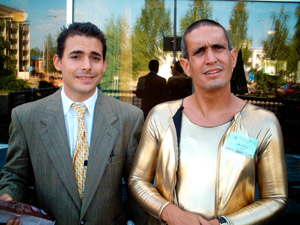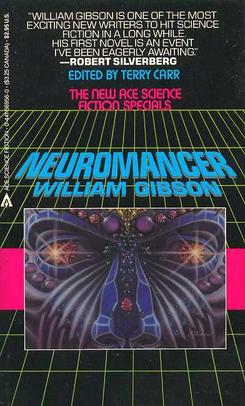A Roleplay-Based Critical Engagement of Historical and Contemporary ‘Hacktivism’
A Precursor to My Final Project
For my final project, I am planning to write about a topic which endlessly fascinates me as someone who makes a habit of learning new computer script and language. I want to explore how global hacktivism (ie, hacking for a political purpose) essentially creates its own ‘placeless’ identities through the internet (in contrast to alternative place-based visions of the future). With the all-encompassing communities created by global hacktivism, the World Wide Web itself becomes a place, supplanting any physical sense of belonging, of nationalism, of identity—into something entirely virtual and often incomprehensible to the uninitiated.
 the infamous ‘anonymous’ 3chan group terrorizing the Church of Scientology
the infamous ‘anonymous’ 3chan group terrorizing the Church of Scientology
When conducting research on this topic, I have come across an infinite number of mystifying ‘famous hacks’ conducted by anonymous (and sometimes not so anonymous) hackers worldwide. While analyzing the effectiveness and resonance of these iconic hacks, I have started to wonder something that, perhaps, shows how completely immersed I personally am in the virtual, unreal world of the Internet and of science fiction and hack mythology surrounding its webs.
The question I have found myself constantly wondering is thus: What would fiction’s ‘Master Hackers’ think of today’s most iconic hacks? Would they secretly be impressed? Would they laugh at the infantile methods of the still-fledgling hack scene which has, arguably, only existed since the early 1990’s? Would our hacking society—our virtual hacking nation—be seen as pathetic in comparison to virtual hacks of lore found in novels by Jeff Noon, William Gibson and Melville?
To answer this question, I will engage in a method hackers themselves love to employ—role-play. Through my two alternate role-playing identities, I will analyze and judge three famous hacks. Roles to be played are the character of our future’s hack ‘god’ Chase from William Gibson’s Neuromancer, and the (debatable) hacker from another dimension—Weaver from China Melville’s Perdido Street Station.
—————————————————————-
HACK#1 1999- WTO HACK
In 1999, 10 days before the WTO’s yearly meeting in Seattle, ®TMark published http://gatt.org, a website parody of the actual WTO site with news headlines such as “WTO Announces Formalized Slavery Market For Africa”. It was so realistic a parody that the organizers of a related conference in Salzburg, Austria actually mistakenly invited a hacktivist from the site to speak at the session on international trade. As a result, the speaker (‘Dr. Bichlbauer’) proposed what he felt the WTO already insists upon. One worried journalist from the confrerence wrote that he “appeared to believe that Italians have a lesser work ethic than the Dutch, that Americans would be better off auctioning their votes in the next election to the highest bidder, and that the primary role of the WTO was to create a one-world culture!” The WTO issued a press release condemning Gatt.org, which was responded with by ®TMark whose press release also obtained a great deal of press, resulting in so much web traffic to the site that some actually “surmised the WTO’s real publicity had really been a form of cyber terrorism against Gatt.org’s server!”
 creators of the fake WTO website
creators of the fake WTO website
CHASE’S ANALYSIS: I’m into this, I guess. (shrug) Somebody’s gotta be funny around here. I mean, here comes the real fuckin’ meat, right? Showing the big corporation assholes who has the Hosaka here. I mean, you guys jack in… have real jurisdiction when you fuck with someone’s meat and real life shit… but they’re going to be pissed. Watch out for military types, mercenaries, no one as good as Molly of course, but they’re gonna have some killer weaponry and if I were you I’d watch my fuckin’ back. Worth it though… worth it…. Dixie’d be proud.
WEAVER’S ANALYSIS: REAVER TEARING WORLDWEAVE YOU DANCED A BLOODTHIRSTY DUET EACH LITTLE SKILLFUL ATTEMPT COMING AROUND AND ATTACKING RIGHT DIGNITY CRUSHED LIKE SO MUCH GRAVEL TIME TO FLEE VIOLENCE DASTARDLY BROTHERSISTER COUNTRY HUMOR IS DELICATE ALL THE MORE WHAT INCRICATE THREADS THAT WILL BE WEAVE WELL.
—————————————————————-
HACK#2 2000- E-TOY HACK
An avant-garde artist website called ‘etoy’ http://www.etoy.com/ had been online for two years when a company called E-Toys http://www.etoys.com/home/index.jsp formed with an online toystore—the company decided to get rid of its ‘competitor’ etoy by suing the site and shutting it down for ‘infringing on our brand name.’ As a result, infuriated online hacktivists across the world launched TOYWAR, which “worked like a swarm of bees” as hundreds of anonymous supporters “contested the aggressor on every level.” The result: within two months, E-Toys Inc. stock on Nasdaq had dropped form $67 to $15 (the day E-Toys Inc. finally dropped the case). In other words, E-Toys suffered $4.5 billion in damage in what was arguably the “most expensive avant-garde performance in art history.”
 one of many TOYWAR images created by fans
one of many TOYWAR images created by fans
CHASE’S ANALYSIS: Kids’ show. Should’ve got you an AI type machine, attack ‘em from the inside, besides just cash. Really get into the ice, you got me? Corporation shit is so much bullshit. Buncha Armitage-style drones doin’ whatever their boss tells ‘em. Corps run the show here, but that doesn’t mean we have to let ‘em… jack into some ice and really do some damage next time. I think you oughta have sense enough to take advantage of unnatural states, man…. Piss off your own Sense/Net, you know?
WEAVER’S ANALYSIS: REGROUP AND REGROUP BESERK THE BICKER AND GASH I TRIUMVIRATE AND SCAMPER YET SAFETY IS NOT NECESSARY WE WILL GO DOMEWARD AND WE WILL SEE THEE AND THEY WILL RUN BEAUFITUL THREADS YOU WEAVE TOGETHER AND AGAINST ONE ANOTHER LIVELY COLORFUL LITTLE ONES SKILFUL FIXING THE RUCKS AND YET TEARING AT ONE ANOTHER IN THE WEBS GRIM AND GRIMY THE FIGHT IS.
—————————————————————-
HACK#3 2006- ‘GULAG’ CAMPAIGN
Early in 2006, infamous anti-censorship hacking group ‘Cult of the Dead Cow,’ responsible for several initiatives against the Chinese government for its Internet censorship policy, launched the ‘goolag’ campaign (the word is based on ‘gulag’, from the horrific Soviet concentration/work camps made most famous during Stalin’s reign) to fight Google’s decision to comply with China’s internet censorship policy in mainland China. The campaign involved a parodied google interface which read “goolag: exporting censorship, one search at a time.” The ‘Goolag’ logo was used in real life several times, namely by Students for a Free Tibet, which used it at rallies and sold t-shirts; the cDC issued official press releases about the campaign, writing that “congress jerks off, gang of four (other computer companies also complying with China’s demands) reaches for raincoats.” The press release was used by several news sources. Despite the action, China still censors its citizens on the Internet, with more than 30,000 Chinese ‘Internet police’ still working.
 official ‘goolag’ logo
official ‘goolag’ logo
CHASE’S ANALYSIS: You guys need someone like Rivera on your side- do some fancy illusion-type tricks, wreak some real havoc. You’re breakin’ my heart with this juvenile bullshit. I mean… fuckin’ T-shirts? This is makin’ me bitter….makin’ me think I need a drink. Here’s what you do—get a rebel AI, Ratz-style, find a flat on Freeside, get you a real Hosaka, slot in a virus, right to their core.
WEAVER’S ANALYSIS: SLOSHING METAL WASTED MIX IN MIRE MIRROR BURSTING WITH BUBBLES OF WASTED BRIANWAVEFORMS WEAVING IS UNHAPPY WITH LESS COLORS LESS INTRICATE PATTERNS NO MASTER CRAFTY CONCURRED FUNNELSPACE IS FLAT AND FEATURELESS CITYWEB CENTER SEES US WE ARE NOT HIDDEN THE STATE PREVAILS OVER YOUR COLORLESS LANDSCAPE TIME SPACE VOID BLACK DARKNESS AVAIL YOURSELF OF EXPLOITATION AND MANIPULATE THE WEB CORRECT.
—————————————————————-
Overall, it appears that Chase and the Weaver, while slightly appreciative of the first two hacks, are not impressed with the third ‘Goolag’ hack. Both analyses appear to find it lacking in both creativity and effectiveness. It looks like our hacking adeptness has a long way to go, but we are young yet in the grand scheme of things and many great hacks no doubt await us all, just around the corner of the World Wide Web, lurking like the Weaver until a colorful scenario presents itself for the picking.
—————————————————————-

Sources
E-Toy information http://sniggle.net/hacktivism.php, WTO site: http://rtmark.com/gatt.html, Neuromancer, William Gibson, Perdido St. Station, China Melville, ®TMark, Protest, Parody Sites and Legalities http://www.chillingeffects.org/protest/faq.cgi,
 The city is the most expressive manifestation of the ever-present tendency to remake the world around us. In the words of Robert Park, “If the city is the world which man created, it is also the world in which he is henceforth condemned to live. Thus, indirectly, and without any clear sense of the nature of his task, in making the city man has remade himself” (23).
The city is the most expressive manifestation of the ever-present tendency to remake the world around us. In the words of Robert Park, “If the city is the world which man created, it is also the world in which he is henceforth condemned to live. Thus, indirectly, and without any clear sense of the nature of his task, in making the city man has remade himself” (23).  Reclaiming urban spaces is an attempt to assert this right. We saw it as protesters marched in the “no-protest zones” in Seattle of 1999, and we see it everyday when the homeless reclaim public spaces as police try to push them along (Vancouver’s Downtown Ambassadors now do this micro-policing on behalf of the private sector).
Reclaiming urban spaces is an attempt to assert this right. We saw it as protesters marched in the “no-protest zones” in Seattle of 1999, and we see it everyday when the homeless reclaim public spaces as police try to push them along (Vancouver’s Downtown Ambassadors now do this micro-policing on behalf of the private sector). 
 the infamous ‘anonymous’ 3chan group terrorizing the Church of Scientology
the infamous ‘anonymous’ 3chan group terrorizing the Church of Scientology creators of the fake WTO website
creators of the fake WTO website one of many TOYWAR images created by fans
one of many TOYWAR images created by fans official ‘goolag’ logo
official ‘goolag’ logo








 Beyond the descriptions of it being a “consensual hallucination” of “disembodied consciousness”, Cyberspace to Gibson is structurally characterized by its now-infamous description as a “grid-space” or “
Beyond the descriptions of it being a “consensual hallucination” of “disembodied consciousness”, Cyberspace to Gibson is structurally characterized by its now-infamous description as a “grid-space” or “

